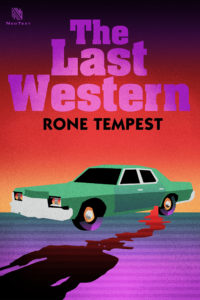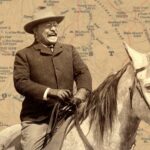Attorney Gerry Spence: “Who is Ed Cantrell?”
Ed Cantrell: “A year and a half ago. I think I could have answered that question for you without a lot of struggling and stumbling, but now, I don’t know. What I really am is a man charged with First Degree Murder.”
—Testimony from 1979 Cantrell murder trial in Pinedale, Wyoming
___________________________________
Before he became enchanted with Wyoming and its cowboy ethos and before he transformed himself so completely into a nineteenth century-style Western gunfighter-lawman, Edward Lee “Eddie” Cantrell was a suburban Indiana schoolboy who dreamed of being a baseball coach.
Cantrell was born December 21, 1927 in Bloomington, Indiana, the son of Nazarene Church pastor Rev. Samuel Glenn Cantrell and Vesta Marie Robinson Cantrell. Except for three years he served in the U.S. Army overseas, mostly as a military policeman in occupied Germany, he spent the first 30 years of his life in the outer Indianapolis and Muncie, Indiana, suburbs of Plainfield, Putnamville, Boonville, Shirley, Pendleton, Portland and Danville.
Cantrell had a strict religious upbringing. The Nazarene Church of his era required that he attend church services three times a week—Sunday Morning, Sunday Evening and Wednesday evening—as well as regular revival meetings, weekly youth meetings and an annual camp meeting. The church has since relaxed some of its rules, but in the 1930s and 1940s when Cantrell was growing up, it banned drinking, smoking, gambling, social dancing and even going to the movies.
“In those days we couldn’t even go see a Lassie movie,” recalled Dr. Ron Blake, Indianapolis district superintendent of the Nazarene Church.
Although it rests in the heart of the American Midwest, Indianapolis—and particularly its outer suburbs where Cantrell lived—was a stronghold of the Ku Klux Klan. In the 1920s an estimated 25 percent of the suburban Indianapolis population supported the Klan and its racist, anti-Semitic and anti-Catholic program.
Cantrell’s father’s Nazarene church banned membership in secret societies like the Klan and Freemasons, but it is very likely that at some point in his childhood, Cantrell witnessed the hooded gatherings of Klansmen who permeated the suburban Indianapolis political landscape.
Although he never fully embraced organized religion, Cantrell was close to his fundamentalist Christian parents. He told his son Joe how his dad dutifully drove him to nearby towns to play “semi-pro” baseball when he was only 14 years old.
“We buried him last spring,” a tearful Cantrell told the Pinedale, Wyoming murder trial jury about his father, “but he was a gentleman, very gentle. I never saw him angry in my life. More gentle than I. Had time for me, he always had time for me. When I knew he was dying I got permission from the court to go back. He had never lost faith in me.” It was that last part, about his father never losing faith in his son accused of murder, that caused him to choke up.
But family and friends say an even more important influence on his life was his paternal grandfather and namesake, John Edward Cantrell, whom grandson Eddie often visited at his rural home in southern Indiana south of Bloomington. Grandfather Cantrell introduced the boy to hunting, a life-long passion. At first, he would walk alongside his grandfather, content to carry his gun. Later his grandfather taught him how to shoot and dress his kill. Granddad gave him a pair of calf-high boots with a sheath on the side for his hunting knife. “His grandfather taught him the love of hunting and guns,” said Ed Cantrell’s son Joe, who still lives in Rock Springs where he works for the federal Bureau of Land Management.
“His grandfather and his grandfather’s brothers were all from Tennessee and migrated up there at some point, but they were outdoorsmen and hunters and that kind of thing. I think that’s where he got his love of hunting and guns.”
Whereas Dad was gentle, Granddad was a tough customer. He worked in a rock quarry and carried a handgun. Cantrell loved telling the story of how the senior Cantrell once drove an intruder off his property with a baseball bat. It was clear early that Cantrell favored a man of action more than a man of God. “I have more of my granddad’s characteristics than anyone else’s. I really loved that old man,” he told a Denver Post magazine reporter in 1984.
Cantrell embraced toughness and intransigence. These qualities may have been in him all along, but certainly were part of his adopted Western persona.
Although the family moved frequently as his father changed churches, Ed Cantrell spent all of his high school years in Plainfield, a western Indianapolis suburb that is also the Indianapolis District headquarters of the Nazarene Church. At tiny Plainfield High School, he distinguished himself as a four-sport athlete, excelling at baseball and captaining the basketball team as a wiry, 5-foot-9-inch, 150- pound guard. His nickname on the football squad was “Slick,” suggesting that he was fast and elusive.
The high school athletic success previewed what would be a lifetime of physical conditioning and fitness—marred only by his addiction to unfiltered Camel cigarettes—that included daily martial arts exercises.
The senior class prophecy for 1945 mockingly predicted that in ten years Eddie Cantrell, known for his reserved, laconic but occasionally belligerent nature, would be in Mexico City in 1955 as part of a world-wide tour delivering “good will speeches.”
After high school, Cantrell attended Central Normal College in Danville where he played football and baseball but was a very poor student, collecting mostly “F’s” and “Incompletes” in his courses. His freshman English transcript showed that he only attended one of 12 classes, resulting in another “F”. He even received an “F” in a course entitled “Football,” despite being the starting halfback on the school team.
When Central Normal, a private teachers’ college, went out of business in 1946, the school was taken over by the Indiana Episcopal church and renamed Canterbury College, which Cantrell attended with the same dismal academic results.
By 1948 it was clear that Ed Cantrell was not cut out to be a student, and he enlisted in the U.S. Army, serving as a military policeman in Stuttgart, Germany, as part of the American post-war occupation forces. He told his son Joe how much he respected the German policemen he worked with during his time there.
“They would go into a beer hall or someplace where there was trouble. All the German police had to do was slap their leather holsters with the side of their hand and the place would get instantly quiet. My dad was really impressed with that.”
Cantrell also continued to play baseball on Army teams, making a name for himself as a small but crafty righthanded pitcher. In those days the Army supplied local newspapers with reports on their hometown boys. In 1949, the Plainview Friday Caller reported in an article headlined “Former Local Boy Becomes Outstanding Pitcher” that Cantrell, pitching for the Stuttgart MP team, threw a three-hitter against another military team from Bad Mergenthiem, striking out 14 batters and also hitting a double.
Cantrell returned to Indiana in 1952. With his military savings, he bought a powerful, shiny red, V-Twin Indian Chief motorcycle, which he rode until he had a frightening accident that forced him to lay the bike down on its side. After that, he told his son Joe, he never rode again except on the back of a horse.
After eight weeks of training at Indiana Police Academy in Bloomington, he was sworn in as an Indiana State Police The trooper, assigned first to Portland, Indiana then to Plainfield, his high school town.
On July 10, 1954 he married Norma Louise Gleeson, a pretty, petite farmgirl from Redkey Township near Muncie, Indiana, who was working as a secretary when she met Cantrell. The couple settled down together, raising four children, two boys and two girls: Nancy, Samuel, Joseph and Peggy.
Initially, Cantrell seemed to thrive as a state trooper. He taught judo to cadets at the state police academy and was one of the first officers certified to operate the “drunkometer,” precursor to the breathalyzer. He made the newspapers with a vain attempt to save the life of a depressed World War II veteran who committed suicide by poisoning himself with strychnine.
But after only four years on the force, Cantrell resigned without explanation. It was part of the restlessness he displayed his entire life, seldom staying in one job for more than a few years. For a while he sold used cars in Plainfield at the Costin Buick dealership. Then he took a job as a game warden for the Indiana Department of Conservation.
“I came out here deer hunting and when I saw Wyoming, why, I started a love affair that is still going on.”But in 1956, his last year with the state police, he had traveled to Wyoming on a hunting trip. “It was the first time I was ever west of the Mississippi River,” he recalled in his trial testimony before a jury composed mostly of Pinedale ranchers or ranch hands. “I came out here deer hunting and when I saw Wyoming, why, I started a love affair that is still going on. I just couldn’t wait to live here.”
While on the hunting trip, Cantrell met LaVell Clark Brinkerhoff, popular sheriff of Wyoming’s Big Horn County. Brinkerhoff, a Mormon elder and former highway patrolman who would later head the Wyoming State Bureau of Criminal Identification, was impressed by Cantrell and offered him a job.
“In June 1958,” Cantrell recalled for the jury, “we moved lock, stock and barrel to Lovell, Wyoming and I became a deputy sheriff in Big Horn, Wyoming.”
By this time, Cantrell was 31 years old. He could handle a hunting rifle, shotgun and a knife, but he had little experience riding horses, roping or managing livestock. His skills with a handgun were mostly limited to the little training he had in the military. He had yet to don a cowboy hat or put on a pair of chaps or spurs. In Wyoming terms, he was essentially a midwestern dude—an athletic one, to be sure, and eager to learn, but basically a greenhorn.
***
Over the next 25 years, Edward Lee Cantrell would transform himself through constant practice and voracious reading of True West, Guns and Ammo, Western Horseman and other Western nostalgia magazines—from suburban Indiana schoolboy into the very model of a nineteenth century Western lawman, short on talk and lightning quick with his guns and his fists. He may have been a failed college student back at Central Normal, but he was an intense scholar of Old West lore and legend.
“Ed literally was born in the wrong century,” said longtime Wyoming friend and former Highway Patrol partner Ron Roberson. “He gravitated toward anyone that had that sort of Western mystique about them. He knew a lot about James Butler Hickok. He knew those old timers as though he had lived with them. He studied them. Of course, those names are as common as prairie grass in this country.” Roberson said that when Cantrell first came to Wyoming, he would make special trips to Deadwood, South Dakota, to sit at the knee of a state judge who collected stories about “Wild Bill” Hickock.
Cantrell practiced constantly with his Smith & Wesson handguns—shooting at least 50 rounds a day, sometimes while rolling on the ground like a Hollywood stuntman—until he was regularly winning quick-draw and handgun marksmanship competitions. He perfected an intense bluesteel stare that sent chills down the spines of those who peered into his pale blue eyes. Years before David Carradine introduced martial arts into the Wild West mythology in the Kung Fu television series, Cantrell would quietly practice Kenpo Karate, a self-defense combat system adapted for street fighting. This added an element of oriental physical grace to his nineteenth-century occidental gunslinger persona.
In the end, the transformation was so complete that Life Magazine (“The Gunfighter Rides Again”), Harpers (“The Last Hired Gun”) and countless newspapers and television programs featured him in mostly fawning stories pegged to the reincarnation of the mythical Western gunslinger. Ron Reagan Jr., son of the late U.S. President, interviewed him for “Good Morning America.” Famous photographers William Albert Allard and Charles Guildner competed to capture his image as the quintessential Western character. Cantrell dressed the part too, favoring weathered felt Stetsons, long-sleeve western-cut white shirts with snap buttons, jeans, jean jackets, down vests and black boots with the high angled “Cowboy” heel. To complete the picture, he sported a grey bushy mustache just like that worn by the legendary Wyoming range detective and killer, Tom Horn.
Perhaps the most telling anecdote of Cantrell’s successful transformation came when the actor Robert Duvall, preparing for his role as Augustus McCrea in the 1985 Lonesome Dove television series, hired Cantrell as his personal advisor on the Texas film set. Pointing to Cantrell, Duvall excitedly ordered his Italian makeup artist Manlio Rocchetti to “Make me look just like him.” And he did.
Later on, Cantrell even had a small role in one of the Lonesome Dove prequels, “Dead Man Walks,” exchanging lines in his deep baritone voice with a young Jennifer Garner.


















